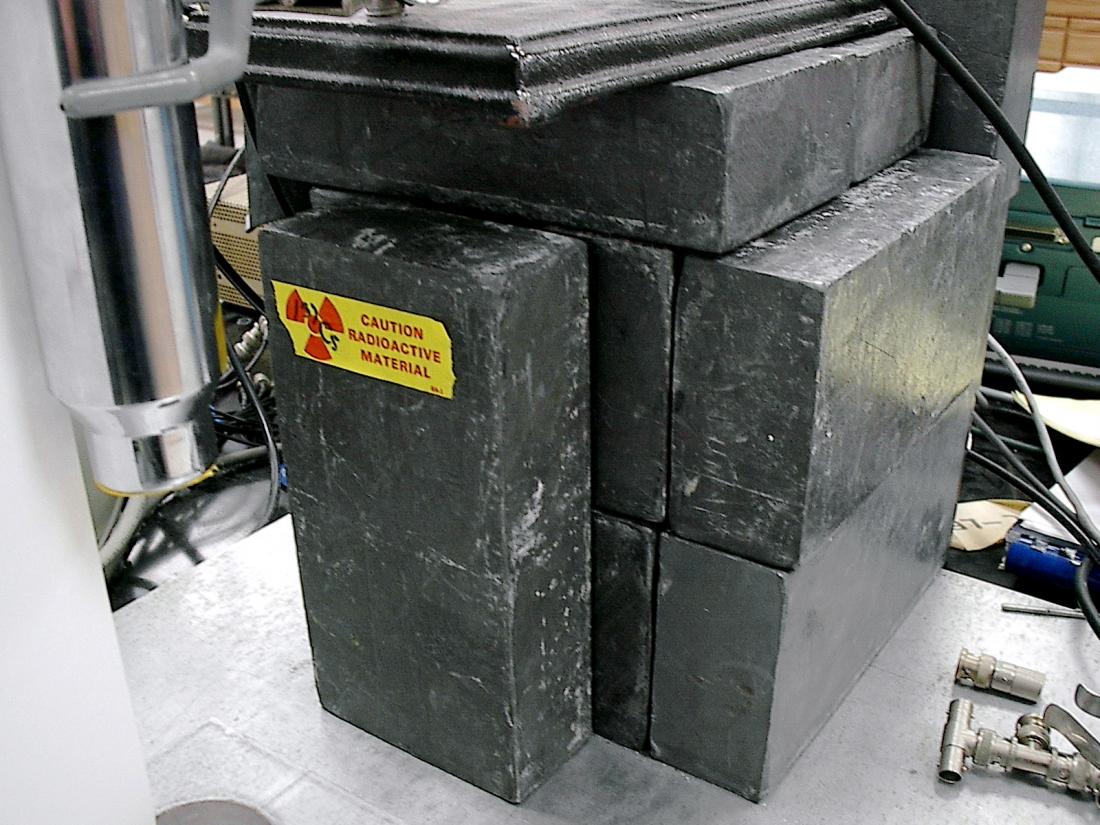Lead bricks being used to shield a radioactive sample (Cs-137).
This press release contains:
· Summaries of newsworthy papers:
--- Irradiation protection
--- Linking the end of an ice age with atmospheric oxygen
· Mention of papers to be published at the same time with the same embargo
· Geographical listing of authors
Editorial contacts: While the best contacts for stories will always be the authors themselves, in some cases the Nature editor who handled the paper will be available for comment if an author is unobtainable. Editors are contactable via Ruth Francis on +44 20 7843 4562. Feel free to get in touch with Nature's press contacts in London, Washington and Tokyo (as listed at the end of this release) with any general editorial inquiry.
Warning: This document, and the Nature Communications papers to which it refers, may contain information that is price sensitive (as legally defined, for example, in the UK Criminal Justice Act 1993 Part V) with respect to publicly quoted companies. Anyone dealing in securities using information contained in this document or in advanced copies of Nature’s content may be guilty of insider trading under the US Securities Exchange Act of 1934.
PICTURES: While we are happy for images from Nature to be reproduced for the purposes of contemporaneous news reporting, you must also seek permission from the copyright holder (if named) or author of the research paper in question (if not).
HYPE: We take great care not to hype the papers mentioned on our press releases, but are sometimes accused of doing so. If you ever consider that a story has been hyped, please do not hesitate to contact us at [email protected], citing the specific example.
[1] Irradiation protection
DOI: 10.1038/ncomms1499
Radiomitigating compounds that can protect mice from lethal does of irradiation are reported in Nature Communications this week. With further development, the work could potentially lead to new measures to counter radiation terrorism, or to protect normal tissues from ionizing irradiation during clinical radiotherapy.
Ionizing radiation induces cell death and is currently used positively in medical applications, such as bone marrow transplantation, where some protective measures are employed against unwanted damage to cells. However, in uncontrolled situations of exposure to radiation, such as during terrorist attacks or exposure of flight crews during extended space missions, the development of protective measures is lagging behind.
Valerian Kagan and co-workers designed and produced oleic and stearic acid derivatives that target mitochondria and inhibit pro-apoptotic oxidative events which lead to cell death. By administering these derivatives to mice they observe that radioprotective effects can be seen in mice treated 1 hour before to 24 hours after irradiation.
The authors suggest that the new ‘pro-oxidant’ enzymatic activity of certain protein complexes shown in this work represents a potential target for anti-apoptotic radioprotective drugs.
CONTACT
Valerian Kagan (University of Pittsburgh, PA, USA)
Tel: +1 412 624 9479; E-mail: [email protected]
[2] Linking the end of an ice age with atmospheric oxygen
DOI: 10.1038/ncomms1507
Evidence for a link between rising atmospheric oxygen and the end of an ice age during the Early Palaeoproterozoic is reported in Nature Communications this week. The result supports previous work, which suggests that as the Earth recovered from an ice age this acted to speed up the rise in the atmospheric oxygen levels, and therefore also helps explain the connection between ice ages which occurred 2.5–2.0 billion years ago and the Great Oxidation Event.
Yasuhito Sekine and colleagues analysed Osmium isotopes in sediments dating from during and after the second Palaeoproterozoic ice age. Their findings, from shallow marine environments, suggest increasing atmospheric oxygen levels during this time are in agreement with the hypothesis that the recovery from the ice age accelerated the Great Oxidation Event.
CONTACT
Yasuhito Sekine (University of Tokyo, Chiba, Japan)
Tel: +81 4 7136 3954; E-mail: [email protected]
Papers to go live at the same time and with the same embargo…
[3] Control of electronic conduction at an oxide heterointerface using surface polar adsorbates
DOI: 10.1038/ncomms1501
[4] Electrosensory ampullary organs are derived from lateral line placodes in bony fishes
DOI: 10.1038/ncomms1502
[5] Single-molecule fluorescence spectroscopy maps the folding landscape of a large protein
DOI: 10.1038/ncomms1504
[6] Bottom-up synthesis of finite models of helical (n,m)-single-wall carbon nanotubes
DOI: 10.1038/ncomms1505
[7] Selective fluorescent probes for live-cell monitoring of sulphide
DOI: 10.1038/ncomms1506
[8] Pericytes resident in postnatal skeletal muscle differentiate into muscle fibres and generate satellite cells
DOI: 10.1038/ncomms1508
[9] The ubiquitin ligase HACE1 regulates Golgi membrane dynamics during the cell cycle
DOI: 10.1038/ncomms1509
[10] Travelling and splitting of a wave of hedgehog expression involved in spider-head segmentation
DOI: 10.1038/ncomms1510
[11] NMDA receptor activation requires remodelling of intersubunit contacts within ligand-binding heterodimers
DOI: 10.1038/ncomms1512
**********************************************************************************************************
GEOGRAPHICAL LISTING OF AUTHORS…
The following list of places refers to the whereabouts of authors on the papers numbered in this release. For example, London: 4 - this means that on paper number four, there will be at least one author affiliated to an institute or company in London. The listing may be for an author's main affiliation, or for a place where they are working temporarily. Please see the PDF of the paper for full details.
CANADA
St Catharines: 1
CHINA
Lanzhou: 7
Nanjing: 7
FRANCE
Paris: 8
GERMANY
Dresden: 9
Heidelberg: 9
ISRAEL
Rehovot: 5
ITALY
Milan: 8
Monza: 8
JAPAN
Chiba: 2, 3
Hyogo: 10
Ibaraki: 2
Kanagawa: 2
Kyoto: 10
Osaka: 10
Sendai: 6
Tokyo: 2
Tsukuba: 2
Yokohama: 10
UNITED KINGDOM
Cambridge: 4
UNITED STATES OF AMERICA
California
San Diego: 4
Stanford: 3
Georgia
Kennesaw: 4
Illinois
Chicago: 7
Michigan
Ann Arbor: 7, 9
New Jersey
Princeton: 5
New York
Buffalo: 11
New York: 4
Pennsylvania
Pittsburgh: 1
PRESS CONTACTS…
From North America and Canada
Neda Afsarmanesh, Nature New York
Tel: +1 212 726 9231; E-mail: [email protected]
From Japan, Korea, China, Singapore and Taiwan
Mika Nakano, Nature Tokyo
Tel: +81 3 3267 8751; E-mail: [email protected]
From the UK
Rachel Twinn, Nature, London
Tel: +44 20 7843 4658; E-mail: [email protected]



